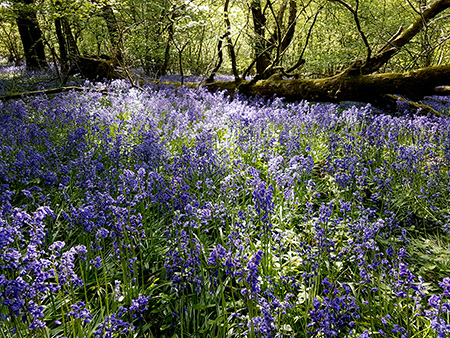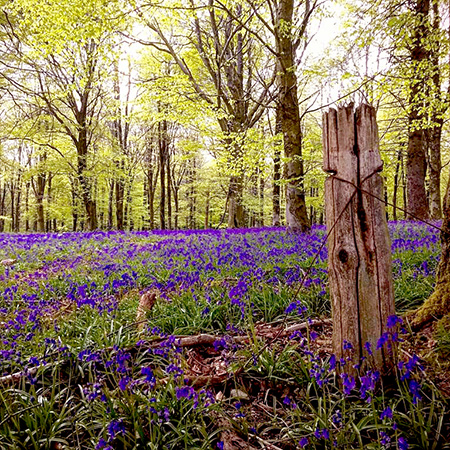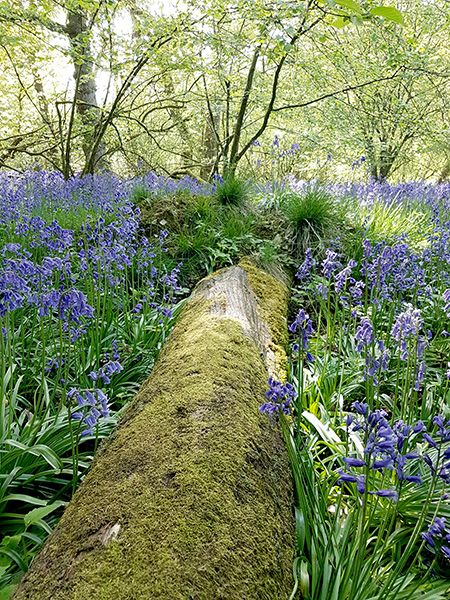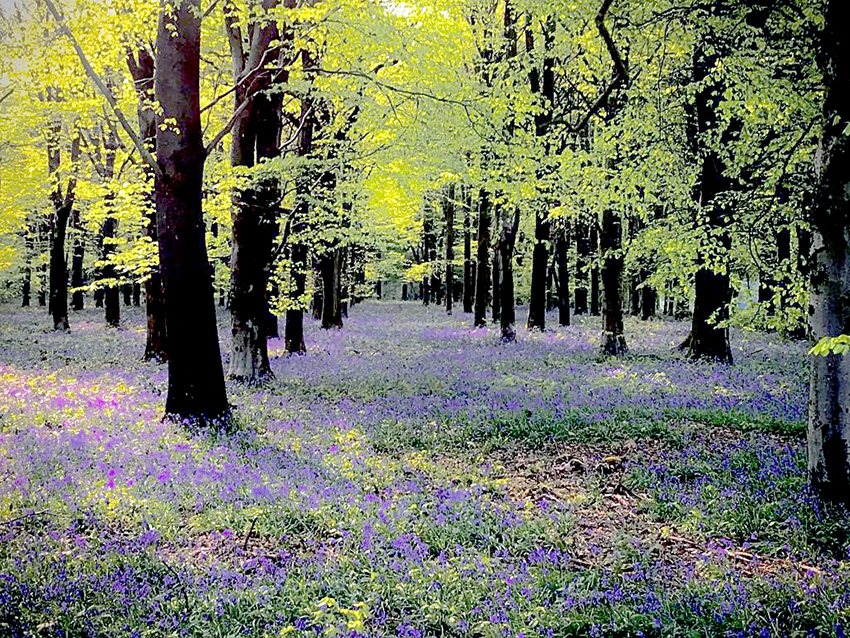

As I walk, I catch the faint smell again: floral and green yet stronger than that and sweet. Deep and beguiling, I know it from memory. Then suddenly swathes of bluebells can be seen washing throughout the woods. They stretch out of sight, winding between and under the trees in an intense azure coloured carpet.
Along the ridgeway, solitary oaks stand and fall in glades and mixed hedgerows mark the old trackways. This is where bluebells find sanctuary. Over half the world’s population of bluebells grow in the UK, mostly amongst trees that are of considerable age. Marking ancient woodlands and byways, they are something positive amidst age and decay.
Bluebells are also called Bell Bottle, Wood Hyacinth, Witches’ Thimbles, Lady’s Nightcap and Wood Bell but whichever name you choose, a broad trail of the scented sky-blue flowers sweeping under oaks, beech and hornbeams unfailingly manages to bewitch every walker.
 However, the “common” bluebell is actually not in the least common and, like so many things, it is rarer than it once was.
However, the “common” bluebell is actually not in the least common and, like so many things, it is rarer than it once was.
Drifts take between five and seven years to establish from seed to flower and are fragile: if you trample over them, they often die as the leaves end up being unable to photosynthesize. Where they are left alone, these unique and complex communities thrive in the undisturbed soils and accumulated decaying wood, with fungi, invertebrates, insects, lichens and other plants. Unfortunately, a bit like the amazon rain forest, these woods are being felled at a shocking rate.
Despite being just a humble woodland flower, the bluebell symbolises everlasting love and was beloved of England’s patron saint, St George. The poet John Keats called it the ‘sapphire queen of the mid-May’, Tennyson described a mass of bluebells as looking like ‘the blue sky, breaking up through the earth’ whilst Gerard Manley Hopkins in his journal of 1871 wrote of ‘the blue-buzzed haze and the waft of intoxicant perfume’.
Naturally, they may well be the secret to the fairy kingdoms, folk lore suggest that the flowers’ bell heads could summon summer fairies to woodland gatherings and traditionally it was considered bad luck to bring a bunch into the house. In fact, these days they must not be picked at all as they are endangered.
It is, however, very possible to plant bluebell bulbs – the native variety – under the spreading branches of a tree perhaps in small irregular clumps. The bulbs need to be placed deep enough so that the white base of the green leaves is covered by soil. Water well and be patient: don’t cut off the foliage and each year they will strengthen in colour.
The poet Gerald Manley Hopkins was both deeply observant of nature and struggled with Victorian industrialism which he felt was deeply damaging and took away the time needed to wonder at the marvels of the natural world. He felt that he lived in an age of vandalism, both actual and spiritual, which did not understand the ‘the greater significance of the growing green.” He wrote “I do not think I have ever seen anything more beautiful than the bluebell I have been looking at. I know the beauty of our Lord by it.”








 Instagram
Instagram
It was lovely to walk through the woodlands of Carnarvon with you as you always make me feel so welcome.
Thank you for bringing the rice history, lovely color and essence of a simpler/richer life
Michele
Thank you Lady Carnarvon for those interesting facts about Bluebells. Houghall wood near my home in Durham is a mecca for people admiring the swaves of Bluebell carpet.
Enjoy your woodland beauty.
Thank you
Dear Lady Carnarvon,
How beautiful your Bluebell Woods are! Where I live I’m afraid all the woodlands & green spaces have been built on – deeply upsetting & not a bluebell or wild flower to be seen anywhere!
I envy you your fabulous Castle & the glorious lands around it, & I think you do a wonderful job maintaining it as well as you do – many congratulations to you all.
Love
Caroline x
They are very beautiful – thank you
Love the bluebells! We have Virginia Bluebells in our area of Illinois. My backyard has lots! It’s one of my signs that spring is trying to come! Today our bluebells were touched by frost.
Lovely picture of fairy land did you and lord Carnarvon have a nice weekend and lovely to visit highcelere castle and l am fan of Downton Abbey
Thank you
Beautiful blue bells in the woods, thank you for sharing with us.
Lady Carnarvon, thank you for highlighting such a magical flower. I fondly remember a similar plant that I loved when I was a little girl. They are named Virginia bluebells and grow in smaller bunches and the bloom is a softer shade of purplish-blue. Rare species should be treasured and protected so future generations can enjoy the magic!
I do agree all species should be treasured
I am not quite sure what future generations will say of us….
Your writings are always so refreshing! Thank you for sharing your knowledge and beauty with us!
Carol Motte, Winder, Ga
Thank you!
We have Virginia bluebells here in Ohio. The foliage is different than yours, but the blooms are the same. I love them! Thank you for your beautiful photos and prose.
A glorious beginning to the week! Thank you!
Visually stunning-only in Britain!
Lady Carnarvon,
It was lovely to see your photos. I too, have taken many photos of the Bluebells blanketing the forest undergrowth in England and thought they looked so lovely and peaceful. Thank you for sharing.
Lady Carnarvon,
I can see in my mind fairies dancing among the bluebells! The picture of the rugged trees among the little flowers is a testament to God’s marvelous creation. Thank you once again for a lovely story.
It is so lovely, it is hard to express…
Dear Lady Carnarvon,
Thank you for yet another lovely insightful piece. I am always impressed and inspired by your love and respect for the environment and your stewardship of the grounds and land on the Highclere Estate.
I was struck by the fact that Bluebells should not be picked to bring indoors as they are endangered. I then realized that I don’t ever pick flowers from our garden. I enjoy capturing them thru my meager talent of photography and leaving them to thrive in the garden!
I am about to plant lots of cosmos plugs – I do need to bring something in the house later on and for some reason I have become addicted to long wild cosmos in a tall vase!
So beautiful, thank you.
fondly Jenny
What beautiful photos.
Just returned last week from a visit to HighClere. We were so struck on how homely it was. Lovely to see such a beautiful castle lived in and cared for. All your staff were so welcoming and helpful. A day to remember. Thankyou
What gorgeous photos of the bluebells. A joy to see on a cloudy and mist filled morning in Vermont (USA).
Richard
How incredibly beautiful your pictures are this morning. My lawns and wild spots are covered with blue and white scilla, myrtle, Dutchman’s britches, blood root, sprouting trilliums, dog tooth violets (soon) and lots of other loveliness that I can’t identify but I’m sure you could tell me.
Here’s to the Wild Woods!
Have a glorious day!
Thank you
What beautiful photographs.
Lovely woods I loved visiting Highclere Castle. I’ve watched downtown Abbey so many times I’m going to come back for a visit
So pleased you liked visiting Highclere
I had the pleasure of visiting Highclere Castle last week with my granddaughter. We had a lovely time and enjoyed the outdoors as much as the inside the house. Thank you.
Spring gardens are beautiful
Dear Lady Carnarvon
My mother moved to Canada from England in her late 20’s. Each Spring she would wistfully describe the English Bluebells to us. About 10 years ago I was lucky enough to be staying at Herstmonceux Castle during Bluebell season – magnificent! They always bring back memories of my Mom…
Thanks for your vivid describption.
A wonderful insight into the life of bluebells. The photographs take me back to my childhood when I spent many an hour in a beautiful bluebell wood.
A week ago today we were visiting Highclere for the first time. What a stunning Castle. It was so interesting to walk around and know the history and see the Egyptian exhibition- especially as my husband is Egyptian! To round off we had the champagne picnic sitting in the grounds. What a wonderful memory.
So pleased you had a lovely day at Highclere
Greetings again Lady Carnarvon and thank you for another beautiful Monday Morning Blog.
When I was lucky to live in London for just under 2 years I was SO impressed and thrilled with how various beautiful perennial floral plants sprouted up in late winter (Snowflake bulbs & daffodills) and covered so many woodlands and then in early Spring so did Bluebells! Lovely for you to walk through and see them all again. Good luck with your next plantings!
Thank you
Magnificent pics! Thanks for sharing.
Beautiful Blue Bells. Thank you sharing these lovely photos.
Beautiful, beautiful, beautiful! As is your wonderful description and history. You always make my Monday mornings so cheerful, so happy ! Thank you !
Barbara Ann
Absolutely charming and enchanting! Thank you.
What exquisite blue “carpeting” you have in the woodlands around the castle! I live in Austin, Texas deep in the heart of Hill Country where in March wild Blue Bonnets bloom much like your Blue Bells. Such a refreshing site! Spring is a wonderful time of renewal and the walk today accomplished that! I felt reinvigorated as you described the fragrance and tenderness of the woods surrounding Highclere. Thank you for the lovely respite and the photos! Almost like being there!
Fabulous to see in real life the bluebell carpeting!
I’m thankful that Texas shares such a beautiful blue bonnet carpet!
Martha G
Cary NC
Living in America for the past 40plus years. One of the things that I miss most about England are woods full of bluebells. Thank you for sharing these lovely photos. I always called it Fairy Land when I was growing up!
Thank you from Warwick NY USA
Gina
I believe that fairies live among my giant purple irises, planted instead of bluebells because of the hot Texas weather. When I cannot find my gardening shoes, have missing art brushes, or find an empty milk carton in the refrigerator (along with the kitchen sponge), I explain it away as just another visit from the mischievous fairies.
Dear Lady Carnarvon
Thank you bringing sunshine into my foggy, rainy day. The pictures of the bluebells are beautiful. The colours of nature are so vivid. No wonder there are stories of the flowers with the fairies. They are magical. Such a beautiful place for quiet time.
Take care
Susan
Lady Carnarvon,
Good Monday morning from Southern California.
I always enjoy reading your stories and seeing your beautiful pictures.
I always learn something new too which is a good way to start my day and week.
The bluebells are beautiful, I’m glad to hear they are being protected. I am sure the fairies are too!
Have a wonderful week.
Sue Bishopp
❤️♂️
You think of the most interesting topics to share with us each wee. I love my Monday morning emails! The bluebells are gorgeous.
Thank you, Lady Carnarvon.
Diana
You think of the most interesting topics to share with us each week. I love my Monday morning emails! The bluebells are gorgeous.
Thank you, Lady Carnarvon.
Diana
Your opening paragraph brought back vivid memories of sires and smells of the bluebell woods at the end of my street in Stanmore, Middlesex where as a child I would wander through. It’s been many years since last there and wonder if the woods even still exist. Thank you for the memories!
Your Bluebell photos look like an ocean of tranquility. Thank you so much for this beautiful visual post
In our little plot here in Vancouver, we don’t have swathes of woodlands but we do have bluebells in our garden. When I’m out in it I have often been told by people passing that they’re a weed and should be pulled out or they’ll spread terribly. My response shocks them, when I say they’re staying, I love seeing my little bit of England when I look out of the window and see them flowering along side the drive and under our 2 ornamental maple trees. I do intend to re-plant some bulbs around the bushes along our back fence this year, then I’ll have them all around me.
I am from Eng also, grew I not far from a Blundell wood, Now live in production B C, and to my joy found bluebells under my hedge.
I apologise. I did check my spelling, my tab changes my messages often which is frustrating.
Thank you, Lady Carnarvon, for another enchanting walk through the nature you hold so precious.
Carolyn
The season of new beginnings!
Lovely
Dear Lady Carnarvan,
How beautiful! Your pictures are absolutely gorgeous. Bluebells have always been a favorite flower of mine. I first learned about them when I was a young girl , reading a Nancy Drew book. What a sad thing that these wonderful flowers are endangered. I hope the bluebells will continue to thrive and grow. Thank you for sharing these amazing pictures and the information about these lovely flowers!
What an emotional Post! I totally agree and appreciate the last quote: sometimes Nature can be an emblem of Beauty.
Enjoy your flowers!
Lady Carnarvon,
Your description of “fairy land” reminded me of one of the scenes in the movie, Finding Neverland with Kate Winslet. Her character in the movie becomes ill, and Peter Pan’s author brings the play to her home, with a fairy-inspired Neverland. Thank you for your care of Highclere.
Dear Lady Carnarvon
Thank you for the lovely blog today.
I love bluebells .I miss them terribly as they do not grow in Ontario Canada. I did so enjoy them growing up in England.
Enjoy the wonderful English spring.
Sincerely
Kathleen in Canada
My dear Lady Carnarvon,
Your writing this week touched me deeply. The pictures caused my soul to soar!
Like Hopkins, I have long contended that I find deeper connection with and knowledge of my Lord more intensely when gazing at a flower. The beauty of God’s creation is staggering when one takes the time to really see it.
Blessings to you and Lord Carnarvon!
Dear Lady Carnarvon:
Thank you for your Monday blog and the brief, but interesting, story behind the “bluebells”.
Very impressive pictures of the floral carpet in the forests. They are gentle reminders of Spring on this cold, winter-like day in Michigan.
Until next week, may you continue to enjoy your walks through the forests and gardens at Highclere Castle.
Perpetua Crawford
I did so enjoy the walk amongst the blue bells Lady Carnarvon. Just going into winter here in New Zealand so it was delightful to see the lovely flowers and learn of their richness through you informative research. Thanks you for such interesting blogs.
Thank You, Lady Carnarvon.
.
“I do not think I have ever seen anything more beautiful than the bluebell I have been looking at. I know the beauty of our Lord by it.”
Gerald Manley Hopkins
.
So nice.
Blessings.
Fairy flowers
The bluebells are so magical and delicate! This is the first time I’ve seen them. Walking among these must make one feel the fragility and resilience of nature. When left alone, it thrives. Thank you for this wonderful entry that introduced me to these beautiful flowers!
Truly a fairyland. Thank you for such lovely words and pictures, Lady Carnarvon.
Bluebells !! I m inspired to read Keats indeed !!!!Thank you Lady Carnarvon . ❤️ Once again a touch of a note from California where we are having a super bloom of golden poppies and lupine for miles on end
“Rolling down the mountainsides to the Golden Gate” We can t pick these either !
Nursery rhyme occurred while reading your today
Bluebells, cockleshells,
Eevy, ivy, over
Where is my jump rope?
How beautiful
Absolutely stunning ,your beautiful words made me feel like I was walking amongst the beautiful bluebells. Your pictures are amazing Gods beautiful creation.
I love the beautiful picture of your Blue Bells. Your pictures make me think of my home state. I live in Texas and we are known for our Bluebonnets. They cover our fields, our roadsides, and everything in between. Don’t you just love how God reminds us of all things he has created to make our hearts sing. Have a wonderful day!
A very interesting bluebell story with beautiful photographs. The climate in the Seattle environs of Western Washington state are similar to yours and we have bluebells in our gardens which are blooming now. I appreciate their beauty even more after reading your article!
Dianne Jones
Kirkland, WA
Lady Carnarvon,
I’ve just come across your blog and was so delighted that the first entry I read was about your magical Blue Bells. Thank you for sharing such lovely photos and the beautiful prose describing them. You’ve given me inspiration for the shady and neglected area of my backyard here in Upstate New York. I just hope the deer don’t find them as irresistible as I do.
Tree Spirits ( nymphs)
My wife and I were drawn to visiting you’re wonderful home through the Downton Abbey television programe like so many and photographed a tree which appears to have a shy tree person looking from behind it which is leaving me with more questions than answers to which I had to bring to your attention.